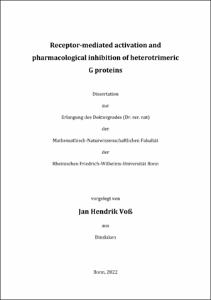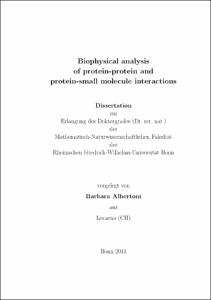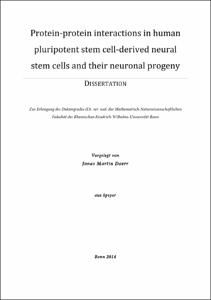Receptor-mediated activation and pharmacological inhibition of heterotrimeric G proteins

Receptor-mediated activation and pharmacological inhibition of heterotrimeric G proteins

| dc.contributor.advisor | Müller, Christa E. | |
| dc.contributor.author | Voß, Jan Hendrik | |
| dc.date.accessioned | 2022-11-14T09:43:16Z | |
| dc.date.available | 2022-11-14T09:43:16Z | |
| dc.date.issued | 14.11.2022 | |
| dc.identifier.uri | https://hdl.handle.net/20.500.11811/10429 | |
| dc.description.abstract | Heterotrimeric guanine-nucleotide binding proteins (G proteins) are key signal transducers in animal and human cells, where they forward signals transmitted by active G protein-coupled receptors (GPCRs) and trigger intracellular signaling cascades. This thesis presents pharmacological studies on (i) macrocyclic GαGa protein inhibitors and (ii) on the Gα protein activation by the adenosine A2B receptor (A2BAR), a promiscuous GPCR.
(i) The structurally related natural products YM-254890 (YM) and FR900359 (FR) are potent and selective inhibitors of the Gαq/11 protein family. Recently, our group developed tritium-labeled derivatives, which display large differences in residence time, despite having a similar affinity for the Gαq protein. We identified lipophilic interactions between the inhibitor binding site and an isopropyl group, which is exclusively present in FR and its derivatives, as the molecular basis for the long residence time of the FR-derived radioligand. Furthermore, our data suggest a complex binding mechanism of macrocyclic Gαq protein inhibitors, involving a conformational selection step. The proposed mechanism was supported by molecular dynamics simulation studies. Next, we established structure-affinity relationships and structure-residence time relationships of a series of YM and FR derivatives. Additionally, YM- and FR-derived radioligands were employed to analyze the Gαq/11 protein expression in mouse tissues by autoradiography. (ii) The A2BAR constitutes a promising drug target for the immunotherapy of cancer. Its physiological functions, however, remain enigmatic. Here, we determine the Gα protein activation fingerprint of the A2BAR by calcium mobilization assays and novel BRET assay systems. In summary, we found that the A2BAR is a promiscuous receptor, which activated nearly all Gα protein subunits. However, it did so with varying degrees of efficacy. It couples most efficaciously to Gαs, Gα15, and Gα12 proteins, but activates all other Gα proteins with submaximal efficacy (< 50% of control receptors). Importantly, each employed agonist displays a different Gα coupling profile. Finally, both the expression levels of the Gα protein and the GPCR are decisive for effective coupling of the A2BAR to a certain Gα protein. Altogether, this work provides profound insights into the molecular pharmacology of macrocyclic Gαq protein inhibitors, focusing on their binding kinetics – a parameter which is gaining recognition in drug design. Furthermore, we created a Gα protein coupling profile of the A2BAR and identified relevant parameters that influence A2BAR-mediated Gα activation to gain more insight into A2BAR signal transmission. | en |
| dc.language.iso | eng | |
| dc.rights | In Copyright | |
| dc.rights.uri | http://rightsstatements.org/vocab/InC/1.0/ | |
| dc.subject | Pharmakologie | |
| dc.subject | G Protein | |
| dc.subject | G Protein-gekoppelte Rezeptoren | |
| dc.subject | FR900359 | |
| dc.subject | YM-254890 | |
| dc.subject | Adenosin | |
| dc.subject | G proteins | |
| dc.subject | G protein-coupled receptors | |
| dc.subject | adenosine | |
| dc.subject.ddc | 615 Pharmakologie, Therapeutik | |
| dc.title | Receptor-mediated activation and pharmacological inhibition of heterotrimeric G proteins | |
| dc.type | Dissertation oder Habilitation | |
| dc.publisher.name | Universitäts- und Landesbibliothek Bonn | |
| dc.publisher.location | Bonn | |
| dc.rights.accessRights | openAccess | |
| dc.identifier.urn | https://nbn-resolving.org/urn:nbn:de:hbz:5-68662 | |
| dc.relation.doi | https://doi.org/10.2174/0929867329666220308112424 | |
| dc.relation.doi | https://doi.org/10.1016/j.phrs.2021.105880 | |
| dc.relation.doi | https://doi.org/10.1021/acsptsci.2c00020 | |
| ulbbn.pubtype | Erstveröffentlichung | |
| ulbbnediss.affiliation.name | Rheinische Friedrich-Wilhelms-Universität Bonn | |
| ulbbnediss.affiliation.location | Bonn | |
| ulbbnediss.thesis.level | Dissertation | |
| ulbbnediss.dissID | 6866 | |
| ulbbnediss.date.accepted | 08.11.2022 | |
| ulbbnediss.institute | Mathematisch-Naturwissenschaftliche Fakultät : Fachgruppe Pharmazie / Pharmazeutisches Institut | |
| ulbbnediss.fakultaet | Mathematisch-Naturwissenschaftliche Fakultät | |
| dc.contributor.coReferee | Schiedel, Anke C. | |
| ulbbnediss.contributor.orcid | https://orcid.org/0000-0003-0595-4607 | |
| ulbbnediss.contributor.gnd | 1276370792 |
Dateien zu dieser Ressource
Das Dokument erscheint in:
-
E-Dissertationen (4337)







